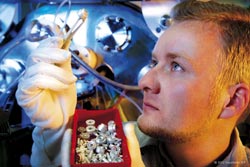Environmentally friendly corrosion protection for rivets

Randomexamination after the coating process<br>© Fraunhofer FEP
Fraunhofer FEP has developed a vacuum process for coating rivets and other small parts as bulk products.
New lightweight design concepts help to reduce the energy that is consumed by cars and rail vehicles. A lower intrinsic weight means lower fuel consumption for cars with combustion engines, longer travel distances for modern electric cars, or a lower required drive power for rail vehicles.
The new combinations of materials which make this possible comprise aluminum alloys, high-strength steel, and fiber reinforced plastics. These heterogeneous materials are joined together mechanically using rivets and glued with adhesives. The rivet elements must be able to withstand very high loads: Vibrations at speeds of more than 100 km/h, aggressive ambient air, high temperatures, and a strong electrochemical potential field due to the very different electrochemical potentials of the incorporated materials.
Effective protection of the rivets against corrosion and wear reduces the maintenance effort and lowers the risk of material failure.
The Fraunhofer Institute for Electron Beam and Plasma Technology FEP has developed a deposition process for efficiently coating bulk rivets with corrosion protection layers. In a slowly rotating drum the rivets are continually and gently mixed and simultaneously coated in the metal vapor. In a pilot plant up to 30 kg rivets can be coated with a multilayer coating stack using plasma enhanced high-rate deposition and pulse magnetron sputtering. By applying the two vacuum technologies a layer system of alternating aluminum layers of about 1 µm thickness and much thinner sputtered diffusion barrier layers can be achieved. Standard test procedures such as the VDA corrosion test (VDA 621-415) demonstrated the excellent corrosion resistance of the coated rivets. Vacuum coating has two major advantages over the galvanic coating methods used until now: Firstly, it is eco-friendly with regard to the materials used. Secondly, hydrogen embrittlement, which can cause fatigue in high-strength steel and titanium substrates, does not occur in vacuum coating processes.
Dr. Heidrun Klostermann, head of the business unit „Coating of components“ at Fraunhofer FEP, describes further potential applications for the process: „Besides rivets, other small mass-produced components such as screws / bolts, pins, balls, links, or nails of size between 0.2 and 4 cm can be coated as bulk products. By combining different vacuum processes a broad range of materials can be deposited. Hence, the technology is ready for plenty of other coating tasks for bulk products.“
Fraunhofer FEP will present samples coated with the described process at PSE 2012 (13th International Conference on Plasma Surface Engineering) in Garmisch-Partenkirchen from 10-14 September 2012. For further information please visit us at our booth or go to our website:
http://www.fep.fraunhofer.de/Components
Scientific contact:
Dr. Heidrun Klostermann
Fraunhofer Institute for Electron Beam and Plasma Technology FEP
Phone +49 351 2586-367
heidrun.klostermann@fep.fraunhofer.de
www.fep.fraunhofer.de
Press contact:
Annett Arnold, M.Sc.
Fraunhofer Institute for Electron Beam and Plasma Technology FEP
Phone +49 351 2586-452
annett.arnold@fep.fraunhofer.de
Media Contact
More Information:
http://www.fep.fraunhofer.de/presseAll latest news from the category: Materials Sciences
Materials management deals with the research, development, manufacturing and processing of raw and industrial materials. Key aspects here are biological and medical issues, which play an increasingly important role in this field.
innovations-report offers in-depth articles related to the development and application of materials and the structure and properties of new materials.
Newest articles

High-energy-density aqueous battery based on halogen multi-electron transfer
Traditional non-aqueous lithium-ion batteries have a high energy density, but their safety is compromised due to the flammable organic electrolytes they utilize. Aqueous batteries use water as the solvent for…

First-ever combined heart pump and pig kidney transplant
…gives new hope to patient with terminal illness. Surgeons at NYU Langone Health performed the first-ever combined mechanical heart pump and gene-edited pig kidney transplant surgery in a 54-year-old woman…

Biophysics: Testing how well biomarkers work
LMU researchers have developed a method to determine how reliably target proteins can be labeled using super-resolution fluorescence microscopy. Modern microscopy techniques make it possible to examine the inner workings…





















